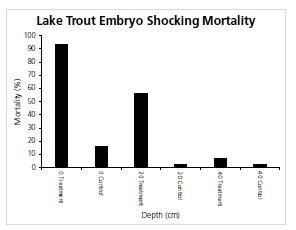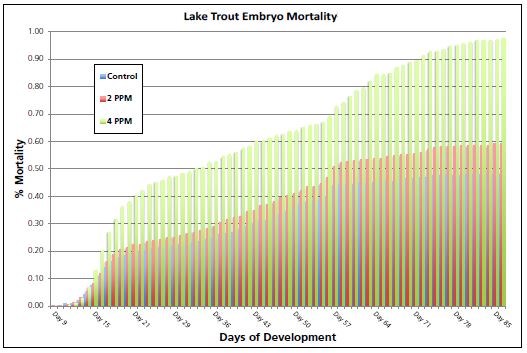|
by Philip D. Doepke, Todd M. Koel, Christopher S. Guy, Alex S. Poole, Nathan A. Thomas, & Alexander V. Zale
We are researching lake trout suppression tactics that involve reducing the survival of embryonic lake trout in Yellowstone Lake. Invasive lake trout spawn over rocky substrates during September and October in Yellowstone Lake. Their spawning style is such that they broadcast eggs into the water column, which then settle to the bottom and often fall between rocks. Within minutes of fertilization, the eggs expand slightly, often causing them to wedge in place between the rocks. Being wedged between rocks protects the eggs from strong currents, making it difficult for predators to eat the eggs. However, being wedged in place may also help the lake trout removal effort; because if we know where the lake trout deposit their eggs, it will be easier for us to remove or treat them in a way that will prevent their survival.
In 2004, a design engineering class at Montana State University investigated some options for killing lake trout eggs, including egg suctioning, resonance, egg/fry traps, fish toxicants, ultrasonics, microwaves, and polymers (Bernhart et al. 2005). Shortly after, investigators at the U.S. Geologic Survey (USGS), Northern Rocky Mountain Science Center, also began work on suppression methods that target early life history stages of lake trout, including electricity, carbon dioxide, ultraviolet light, egg suctioning, and acoustic energy. The USGS investigators’ objectives were to critically assess the ecological effectiveness, cost effectiveness, and safety of alternative methods to destroy lake trout embryos in natural settings, and develop a practical methodology and associated equipment for field use (Gross 2010). Initial studies held some promise, but little field work was conducted in Yellowstone; and equipment for field use was not developed. Following these early exploratory efforts, attempts were made to create equipment that would be mobile and could cause the demise of lake trout embryos on their spawning reefs. Present research efforts by Yellowstone National Park biologists and collaborating scientists at the USGS Montana Cooperative Fishery Research Unit and Montana State University are to locate all lake trout spawning habitats and evaluate the effectiveness of electricity, suction-dredging, tarping, chemical, and lake trout carcass suppression techniques at killing lake trout embryos on spawning sites. Electroshocking GridsMobile electrical shocking devices have proven to be a promising tool for alternative suppression on spawning sites. Previous research demonstrated fish embryos are vulnerable to electric field intensities commonly generated by electrofishing equipment (Bohl et al. 2010). These devices were designed with the simple purpose of delivering a localized electrical shock that would destroy lake trout eggs (Brown 2014). The device that holds the most promise is a mobile 3 x 7 m (23 x 9.8 ft.) grid. The grid is positioned over spawning substrate on the bottom of the lake. Electricity is discharged into the lake substrate between several cables within the frame. Once the area within the grid has been shocked, the grid is lifted and moved to the next site; the process is continued until all the lake trout spawning grounds have been systematically electro-shocked. Water is typically an excellent conductor; therefore, electricity that escapes the grid is quickly reduced to a non-lethal level, preventing the demise of anything outside the grid.Initial results suggest embryos residing near the surface of the substrate were almost entirely killed (figure 1). However, embryos 20-40 cm (7.9-15.8 in.) in the substrate were more likely to survive the electrical shock. Yellowstone Lake water is very pristine, which reduces its ability to conduct an electrical charge. Because of this, embryos that have settled into the substrate are less vulnerable to electrical shock. Thus, the natural purity of the water may limit the usefulness of an electrical grid for killing lake trout in Yellowstone Lake. However, this technique holds promise for other waters where lake trout are invasive. Suction-DredgingA suction dredge is also being tested on Yellowstone Lake, consisting of a large pump placed on the deck of a boat, with long hoses that scour the substrate below and pick up lake trout eggs. The effluent is sucked up to the boat, where it is run through a series of screens. Everything except lake trout egg-sized particles drops back to the bottom of the lake. Egg-sized particles, including lake trout eggs, are separated in a salt water bath; eggs float in the salt water while rocks and pebbles remain on the bottom, allowing eggs to be easily skimmed from the surface. The suction dredge has proven effective at verifying lake trout spawning areas; we now know of 12 lake trout spawning sites in Yellowstone Lake.TarpingTarping is a technique that restricts the flow of water over lake trout eggs so they do not get enough oxygenated water for respiration. Biologists tarp the substrate where eggs have naturally been deposited, thus preventing oxygenated water from flowing over the eggs and ultimately suffocating the developing embryos. The cover currently being tested is a plastic tarp, but other materials that would act similarly or better at restricting water flow are being considered. Tarping studies are being conducted at the Carrington Island spawning site.Chemical TreatmentAn embryo toxicology study is attempting to determine the effectiveness and feasibility of various chemical compounds in the suppression of lake trout embryos. An initial pilot study completed in January 2016 assessed the potential of two compounds to cause embryonic mortality: salt (common stock salt, 99% NaCl) and rotenone, an organic fish toxicant commonly used by biologists to remove non-native fish. Long-term exposure (up to 21 days) of freshwater fish embryos to elevated salt concentrations has been shown to reduce hatching success (Koel and Peterka 1995), but what was not known is if short-term exposure (less than 1 day) to salt would affect their survival.The effectiveness of rotenone for removing juvenile and adult fish is well documented, and the chemical is used for this purpose annually. However, developing embryos are protected by a nearly impermeable outer chorion (shell), and it was not known if rotenone can pass through the chorion or increase mortality of embryos in any way. The results of the pilot study suggested short-term exposure (4-12 hours) of embryos to salt concentrations up to 5,000 mg per liter does not increase mortality. However, short-term exposure of lake trout embryos to a rotenone concentration of 4 parts-per-million resulted in an average cumulative mortality rate of 98% (figure 2). Thus far, all trials have been conducted in a laboratory environment; we now need to expose eggs in Yellowstone Lake to this low concentration of rotenone and examine its effectiveness. One of the greatest benefits of a chemical treatment would be its ability to reach eggs that are wedged between rocks and too difficult to remove by vacuum (suction-dredge) or have settled too deep into the substrate for an electrical grid to deliver a lethal shock. Lake Trout CarcassesLake trout spawn in late September and early October in Yellowstone Lake. Some lake trout spawning areas are in water more than 20 m (65 ft.) deep, thereby limiting some viable methods (e.g., electroshocking).One alternative suppression method fisheries crews could feasibly apply at all depths is the placement of lake trout carcasses. During September and October of 2016 we dumped several hundred lake trout carcasses on three of the twelve known lake trout spawning grounds in Yellowstone Lake. Prior to dumping the carcasses, we placed trays with several thousand developing lake trout embryos on these spawning grounds to determine if we could cause mortality. After just 16 days there was almost 100% mortality of the lake trout embryos. Carcasses placed at 0-20 cm (0-8 in.) showed an average mortality of 99.4% (86-100%) as compared to the control group mortality of 46.6% (29-75%). These are very promising results. Lake trout embryos would typically take over 90 days to hatch in the water temperatures of Yellowstone Lake. Dumping lake trout carcasses in Yellowstone Lake is something that has been occurring since the removal project started. The gillnetting aspect of the lake trout removal project has been dumping more than 300,000 lake trout carcasses in the deep waters of Yellowstone Lake annually for the last several years. If we just dump a small portion of these on the lake trout spawning grounds we may be able to greatly reduce lake trout recruitment. We will continue to research this technique to determine minimum amount of carcass material necessary to cause mortality and if there are any drawbacks to dumping fish carcasses in relatively shallow water (1-30 meters in depth). SummaryAdditional fisheries research in Yellowstone Lake is complimenting studies on alternative suppression methods, by locating lake trout spawning areas and delineating their outer margins. Finding ways to limit the number of lake trout eggs has great potential because lake trout have specific areas where they spawn. If we find a method that removes or destroys developing eggs, we could remove numerous lake trout from Yellowstone Lake by treating only a small portion of the lake. The search for suppression alternatives will continue as long as there is a need to remove lake trout. As gillnetting removes more lake trout from Yellowstone Lake, the cutthroat trout population will increase, making bycatch (the accidental catch of cutthroat trout) more of a concern. This bycatch issue emphasizes the need to find alternatives to gillnetting for future fisheries management. It is possible that the use of several methods to attack multiple developmental stages of lake trout will be the best strategy to allow the native cutthroat trout population in Yellowstone Lake to recover.Literature CitedBernhart, B., C. Blackwood, R. Gale, E. Held, D. Shaffer, M. Wells, and D. Weston. 2005. Yellowstone National Park lake trout crisis. ME 404/ChE 411, Senior Design. Montana State University, Bozeman, Montana, USA.Bohl, R.J., T.B. Henry, and R.J. Strange. 2010. Electroshock-induced mortality in freshwater fish embryos increases with embryo diameter: a model based on results from 10 species. Journal of Fish Biology 76:975-986. Brown, P.J., C.S. Guy, and M.H. Meeuwig. 2014. Use of electrofishing to induce mortality in lake trout embryos in Yellowstone Lake. Final Report. Montana State University, Bozeman, Montana, USA. Gross, J., R.E. Gresswell, and M. Webb. 2010. Destruction of lake trout Salvelinus namaycush embryos in natural settings to enhance persistence of native trout. U.S. Geological Survey Northern Rocky Mountain Science Center, Bozeman, Montana, USA. Koel, T.M., and J.J. Peterka. 1995. Survival to hatching of fishes in sulfate-saline waters, Devils Lake, North Dakota. Canadian Journal of Fisheries and Aquatic Sciences 52:464-469. Phil Doepke is a fisheries biologist working in Yellowstone National Park since 2003. Phil is a Yooper, born and raised in the Upper Peninsula of Michigan. He studied Fisheries and Resource Management practices at Northern Michigan, Michigan State, Michigan Tech, and Utah State universities. Previous employment locations have been the Ottawa National Forest, Bighorn National Forest, U.S. Fish and Wildlife Service in Marquette, MI, and the Great Lakes Indian Fish and Wildlife Commission. Most of his current work deals with the lake trout removal project in Yellowstone Lake. 

|
Last updated: February 17, 2017
